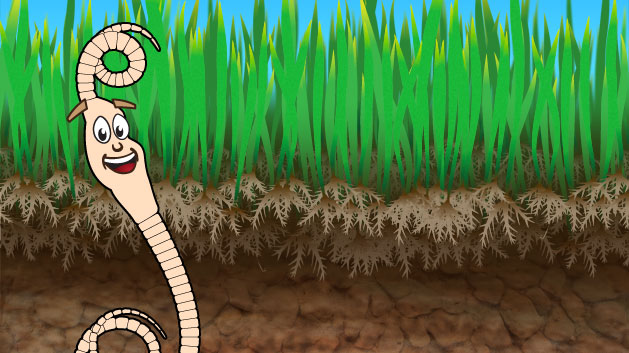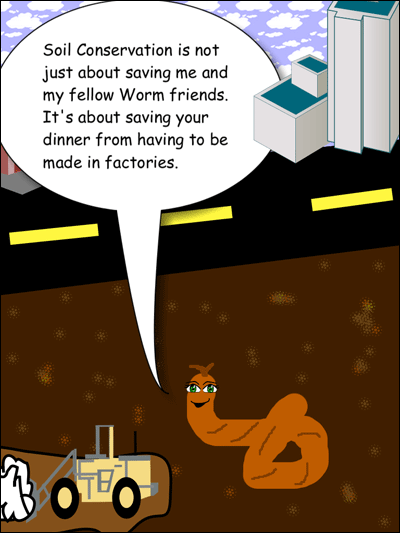
Students will investigate different types of soil. Using Diary of a Worm as inspiration, they will create a media campaign to educate others about the layers, components, and inhabitants of soil and explain why soil is beneficial.
Apps: Wixie

In a move to reduce landscaping budgets and keep their yards and businesses cleaner, many people are paving over areas of dirt around their homes and stores. Fortunately, you know that dirt is more than just dirt - it’s soil, home to creatures and plants that are important to the Earth’s health.
Create a campaign to stop the paving and preserve the soil. Design media products, including pamphlets, comics, and videos, to educate students, parents, teachers, administrators, and the community about the benefits of soil and alternative solutions to paving, such as greenways and gardens. Use your media products to share a media campaign to stop the paving!
There are many types of soil, each with its own unique characteristics and benefits for the ecosystem in which it is found. Bring different types of soil into your classroom as well as investigate different types of soil found around your school and community. Discuss the characteristics of each type of soil and document with pictures, descriptive words and research of uses, including the pros and cons of using specific soils for different purposes.
Students should be able to answer:
Read Doreen Cronin’s Diary of a Worm. Ask students to explain the benefits of soil and what role a worm plays in the ecosystem. Discuss the practice of paving over “dirt” to save money.
Discuss ways students could educate others about the benefits of soil, such as stories, brochures, public service announcements, or comics.
Let students know they will be responsible for educating others about the benefits of soil. Form small teams of students and have them list the stories, facts, and ideas they think will be helpful in making a successful argument. Teams should review their notes, complete additional research, and develop a plan for the product they will create to educate others.
Have teams share their proposals with the rest of the class. This allows all teams to benefit from all students’ thorough research, powerful facts, and creative ideas. Ask each team to choose one or two core arguments and begin determine how their team might best make the case to support their position, developing products such as presentations, bumper stickers, posters, public service announcements, children’s stories, brochures, or comics.
Students can use Wixie to develop their materials. Student work should be saved, exported, printed, and published so that it can be shared with others.
Have students present their information to other students at school during an assembly or at a booth on the playground or in the cafeteria.
You might choose to share PSAs on your school web site or present them during morning announcements. You may also be to share the PSAs on your local access television station to help educate the community. Post student videos and web sites to your school web server or to a video sharing community for wider distribution. Brochures can be printed and distributed at local coffee shops and garden stores.
You could also turn this project into a parent night or community event by hosting a “Don’t Pave It!” trade show. Have teams make presentations and share their resources at different booths and make-and-take events.

You can begin to evaluate students’ content knowledge during the initial investigations of soil and from discussions about Diary of a Worm and the paving problem. Ask questions about their research and arguments to evaluate comprehension and understanding. Engaging students in discussion about the information they have found will help you identify misconceptions and better assess understanding before project work begins.
The final presentations and media products will help you evaluate how well students are able to apply knowledge and information to communicate an idea and craft written and visual arguments.
Cronin, Doreen. Diary of a Worm. ISBN: 043969745X
Rosinsky, Natalie. Dirt: The Scoop on Soil. ISBN: 1404803319
Bial, Raymond. A Handful of Dirt. ISBN: 0802786987
Soil Science Society of America
Discovery Education: The Dirt on Soil
Physical Science - CONTENT STANDARD B:
As a result of the activities in grades K-4, all students should develop an understanding of: Properties of objects and materials
Earth and Space Science
Content Standard D
As a result of their activities in grades K-4, all students should develop an understanding of: Properties of earth material
Reading Theme
Key Ideas and Details
1. Read closely to determine what the text says explicitly and to make logical inferences from it; cite specific textual evidence when writing or speaking to support conclusions drawn from the text.
Craft and Structure
4. Interpret words and phrases as they are used in a text, including determining technical, connotative, and figurative meanings, and analyze how specific word choices shape meaning or tone.
6. Assess how point of view or purpose shapes the content and style of a text.
Writing Theme
Text Type and Purpose
2. Write informative/explanatory texts to examine and convey complex ideas and information clearly and accurately through the effective selection, organization, and analysis of content.
Production and Distribution of Writing
4. Produce clear and coherent writing in which the development, organization, and style are appropriate to task, purpose, and audience.
Research to Build Present Knowledge
7. Conduct short as well as more sustained research projects based on focused questions, demonstrating understanding of the subject under investigation.
9. Draw evidence from literary or informational texts to support analysis, reflection, and research.
Range of Writing
10. Write routinely over extended time frames (time for research, reflection, and revision) and shorter time frames (a single sitting or a day or two) for a range of tasks, purposes, and audiences
Speaking and Listening Theme
Comprehension and Collaboration
2. Integrate and evaluate information presented in diverse media and formats, including visually, quantitatively, and orally.
Presentation of Knowledge and Ideas
4. Present information, findings, and supporting evidence such that listeners can follow the line of reasoning and the organization, development, and style are appropriate to task, purpose, and audience.
6. Creative Communicator
Students communicate clearly and express themselves creatively for a variety of purposes using the platforms, tools, styles, formats and digital media appropriate to their goals. Students:
a. choose the appropriate platforms and tools for meeting the desired objectives of their creation or communication.
b. create original works or responsibly repurpose or remix digital resources into new creations.
c. communicate complex ideas clearly and effectively by creating or using a variety of digital objects such as visualizations, models or simulations.
d. publish or present content that customizes the message and medium for their intended audiences.

Follow us on Instagram for daily inspiration

Create a thought web, cluster, flowchart, or other graphic organizer for a lesson
8 first projects to get students using technology
Creative, digital book reviews
Fun and powerful ideas with animated characters

Wixie
Share your ideas, imagination, and understanding through writing, art, voice, and video.

Rubric Maker
Create custom rubrics for your classroom.

Pics4Learning
A curated, copyright-friendly image library that is safe and free for education.

Wriddle
Write, record, and illustrate a sentence.

Get creative classroom ideas delivered straight to your inbox once a month.
Topics